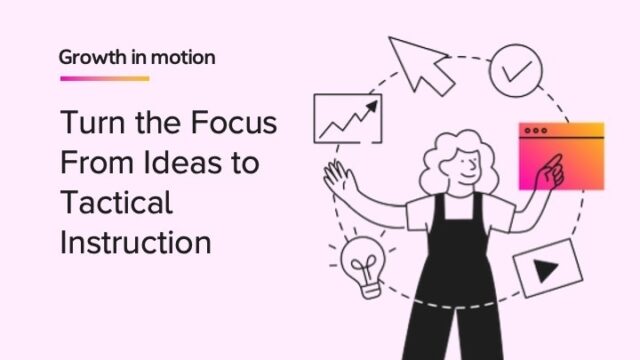
Imagine standing in front of a group of students, passionately expounding upon some great subject, only to realize that nothing you’ve been saying has registered. Or, once testing time rolls around, and you’re convinced that your students have mastered the concepts, you discover they haven’t learned what you had hoped to teach them.
Of course, we don’t teach so that we can stand in front of a bunch of students and just talk at them. We teach, among other reasons, for the opportunity to change lives by imparting useful knowledge and wisdom.
So, how can we know if we’re getting through? How can we know if our students are actually learning what we’re trying to teach them?
Start by writing down the objective
During my years in education, I was taught one particular skill so well that I still use it now, even years after being required to put it into practice. This skill was writing the objective!
Before you teach anything, you need to know what you’re going to teach, how you’ll teach it, and how you’ll know if students have learned it. Simple enough, right? In other words, you need to have a plan for how you will monitor and assess whether or not students are learning the material you’re presenting.
A solid objective consists of two parts: what you’ll teach and how the students prove what they’ve learned. For example, if I were to write an objective for this article, it might be something like, “The learners will demonstrate an understanding of how to monitor and guide student learning by applying some of the below-mentioned methods in their own classroom.”
Now, obviously, in this example, I can’t observe you in your classroom. But ideally, you’d want the second part of the objective to be something you could tangibly monitor and assess.
Monitoring during learning
Monitoring and assessing students will guide you in determining whether or not you need to spend more time on the concept with the class as a whole. That way, you’ll know if you need to give more attention to certain students, if it’s okay to move on, or if you need to pick up the pace.
Monitoring student progress has been shown to have a significant positive impact on student success and is noted as one of the key differences between effective and ineffective teaching.
In a study on monitoring student learning in the classroom, monitoring was defined as “activities pursued by teachers to keep track of student learning for purposes of making instructional decisions and providing feedback to students on their progress.”
Ideally, monitoring student learning, giving feedback, and adjusting your instruction should be a process that takes place throughout the whole lesson. Realistically, that’s a lot to keep track of, especially when you’re first starting out. Fortunately, this skill gets easier with time and practice.
To help you with this learning process, we’ve compiled some ideas below for monitoring student learning at various lesson stages—before, during, and after. Try out an idea or two, and add more as you see fit!
Monitoring student progress at the beginning of the lesson
Entry slips/tickets
Some teachers also call this “daily work” or “board work.” Before the lesson, the students answer review questions on paper to demonstrate their understanding of previously covered material. Be sure to give quick feedback on these tickets.
Grading, out loud and with the whole class, homework from the previous lesson
This is a great way to practice for math or any other class in which new concepts directly build off previously taught material. However, note that some school districts do have restrictions on having students switch papers to grade.
Brief review questions
Ask questions about the main concepts of previous lessons; you can do this in various ways.
- Fill in the blank out loud: Give students a sentence (out loud), but leave out a keyword. Challenge the class to provide the missing word.
- True or false: Give students a true or false question. Then, have them stand if the answer is true and remain seated otherwise.
Making adjustments
If it seems that most students haven’t grasped the previously taught lesson, you may want to spend some extra time reviewing and re-teaching the concept before you move on. If only a few students struggled, be sure to focus on them a bit more during the lesson and any independent work time. If the whole class is on track, yay! Move right along.
Monitoring student progress during the lesson
Eye contact and proximity
While delivering a lesson, survey the room and take mental note of the students’ expressions, postures, and behavior. You can generally tell when a student is confused or distracted. Simply making eye contact and standing close to students who aren’t paying attention can work wonders. As for those who look confused, pause and check in with them to see how well they understand you. Many students will not take the initiative to tell you when they’re lost.
“Stoplight”
This simple (but effective) activity involves giving students red, yellow, and green cards or cups. Students display green when they understand the concept, yellow when they’re a little confused, and red when they’re completely lost. This teacher monitoring technique can help you keep track of the pace of your lesson and can be used for individual seat work as well.
“1, 2, 3”
This one’s similar to Stoplight. Throughout the lesson, periodically stop and ask students if they understand the concept. Students hold up three fingers if they understand, two if they kind of understand but are a little confused, and one if they have no idea what you’re talking about.
Questioning
This may seem obvious, but it’s too often overlooked. Ask frequent questions to check for understanding and attention. This also provides extra motivation for students to pay attention, since they know they’ll be held accountable for knowing the information if they’re called on. Keep track of whom you’ve called on and who answered correctly.
Board work
Math, grammar, and spelling are especially good subjects for using board work. If the students have individual boards, they can do the work and hold up their answers. You can also pair students and have one partner do the work on the classroom board while the other does the same problem at their desk (either on paper or a small whiteboard). The student at the desk is responsible for “checking” their partner’s work with their own work. Monitor both sets of students and address any misunderstandings that reveal themselves.
Making adjustments (again!)
If most students don’t seem to understand the lesson, you may want to slow down and reevaluate how you’re communicating with them. You may need to re-teach the lesson step by step. If only a few students seem confused, be sure to focus on them a bit more during any independent work time. Feel free to move right along if the whole class on track.
Monitoring student progress at the end of the lesson
Interactive multiple choice
Ask students a multiple-choice question, but instead of having them respond with either A, B, or C, use:
- Classroom corners: Designate certain places in the room as A, B, or C. Instead of verbally answering the question, students walk to a designated area.
- Letter cards: In this activity, each student has a set of letter cards with multiple-choice letter options. They hold up a card to answer the question.
Circulating and engaging
If you’ve given your students seatwork to practice the lesson skills, continually circulate among them and check in on how they’re doing. Provide feedback on their work and guidance if they need it.
Exit slips/tickets
Exit slips/tickets are like the entry slips but at the end of class. Give the students a question, either verbally or written on the board or on slips of paper. Then, ask them to write the answer and turn it in. Be sure to provide feedback on these slips and return them during the next class.
Continue to make adjustments
If it still seems that most students haven’t grasped the lesson, make a note to re-teach the exercise in the next class period (you could do this in a brief mini-lesson). It also gives them more time to practice their new skills. If only a few students struggled, be sure to focus on them a bit more during any independent work time. You may also want to adjust the pace a bit for these students so that they don’t fall too far behind. Pairing them up during work time with a student who understands the concept better is another option.
Concerning homework
There tends to be a wide range of opinions on homework with some saying you shouldn’t give it. For those who give homework, how often and how much is still debated.
Results from the study on monitoring during learning suggested that those who assign homework should ensure it’s given on a regular basis. They should also ensure homework is directly related to the knowledge and skills taught in the lesson (no busy work), and provide immediate feedback on any work. Homework under these conditions improved student performance and also resulted in students having a more positive attitude toward it.
Concerning tests
Tests are similar to homework in terms of their controversy. Interestingly enough, the findings for testing were very much like those for homework. If tests were administered regularly, directly pertained to the information that was taught and practiced, and were promptly graded and returned with appropriate feedback, then student performance and attitudes improved.
Purposeful talking
People talk for the sake of being heard. Teachers talk for the sake of transferring knowledge and wisdom. They monitor to determine if the knowledge has transferred. They adjust their instruction to meet the needs of their findings. Ultimately, they do all of this to make a difference.
This article was adapted from a blog post initially developed by the education technology company Classcraft, which was acquired by HMH in 2023. The views expressed in this article are those of the author and do not necessarily represent those of HMH.
***
Find more lesson plans and classroom resources on Shaped.
Be the first to read the latest from HMH’s blog, Shaped.














